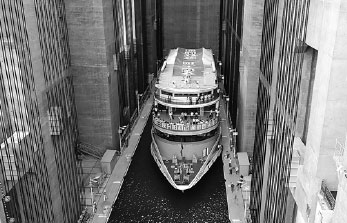Colossal lift for ships tested at Three Gorges
|
A cruise ship is lowered to the bottom of a ship-lift at the Three Gorges Dam in Hubei province on Sunday. The lift is said to be the largest and most sophisticated in the world. Cheng Min / Xinhua |
Trial operation of a permanent ship-lift at the Three Gorges Dam in Hubei province began on Sunday, marking the completion of the Three Gorges project 22 years after construction began.
The lift, designed by a Chinese and German team, is the largest and most sophisticated in the world, according to Three Gorges Co, the State-owned company responsible for construction.
The vertical-hoisting elevator is designed for small and medium-sized ships - those with a maximum displacement of about 3,000 tons - to traverse the dam. The water level behind the dam may be as much as 113 meters higher than the river.
The lift is equipped with a ship-chamber, which contains a pool of water 120 meters long, 18 meters wide and 3.5 meters deep. The chamber, its mechanical systems and the water weigh 15,500 metric tons altogether.
The lift has been installed to complement the adjacent five-tier ship lock, which is also the world's largest. It has allowed ships to pass through since 2003.
The lock is currently running at full capacity, with cargo throughput of 119.6 million tons in 2015 - a massive increase over its 34.31 million tons a decade earlier. The increase has been attributed to the booming water transportation sector along the mountainous regions of the Three Gorges, including Chongqing municipality.
It once took a ship about three to four hours to pass the dam via the lock. The lift will cut this time to between 40 minutes and one hour.
The Three Gorges project is a multifunctional water control system, consisting of a 2,309-meter long and 185-meter high dam, a five-tier ship lock, 32 hydropower turbogenerators and the new ship-lift.
The lift was in the original plan passed by the National People's Congress, China's top legislature, in 1992. Because of technical and safety concerns, that part of the project was put on hold in 1994.
By the end of 2009, all other construction work at the dam had been completed.
The original plan was to build a lifting mechanism based on a wire-rope hoist. Experts, however, were concerned about its colossal scale and feared the tank used to carry vessels would be unstable, said Lu Youmei, former general manager of China Three Gorges Corp.
In 2003, gear mechanisms and nut-screw safety measures from Germany were introduced to replace the original plan, and work resumed in 2008.
The new approach helps keep the lift balanced and is far superior to the wire-rope hoist method, said Lu, who is also an academic with the Chinese Academy of Engineering.
Over the past eight years, many advances have been made. New standards were set for steel smelting, civil engineering and management, thanks to the construction of the ship-lift, said Wu Xiaoyun, deputy director of the mechanical and electrical engineering department of Three Gorges Co.
Boosting the shipping capacity of the Yangtze, China's longest river, was one of the three major purposes of the Three Gorges project, along with flood control and power generation.
Before the creation of the Three Gorges reservoir in 2003, the upper reaches of the Yangtze were off-limits to big vessels, as the river was too narrow and shallow, and its many winding and turbulent stretches - known as "ghost gates" - were dangerous for small boats.



















